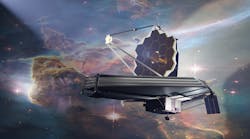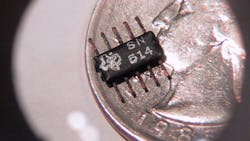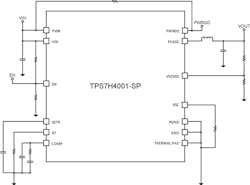Space Engineering Enters Its Next Frontier
Members can download this article in PDF format.
As space engineering enters the next frontier, space programs will require the ultimate in compact, reliable, low-power, high-performance ICs. Such devices are finding use in spacecraft ranging from the James Webb Space Telescope to an emerging generation of small satellites. These ICs include data converters, power-management ICs, op amps, digital signal processors, transceivers, and logic chips.
A key milestone in the emergence of ICs for space applications occurred in 1961, when integrated-circuit pioneer Jack Kilby of Texas Instruments handpicked Charles “Bob” Cook to be the lead engineer for a NASA project. NASA wanted to reduce the size and weight of the modules it would use in its manned space program while increasing their computing power. TI had previously provided NASA with the SN502 digital IC, but NASA needed a device with 10X the speed and one-tenth the power consumption—and they needed it within 10 months.
Sponsored Resources:
- Space-grade ICs help the James Webb Telescope peer deep into the cosmos
- Developing the first ICs to orbit Earth
- Small satellites, big advances
First ICs in Orbit
At the time, manufacturing yields in the semiconductor industry were low, but Cook and TI management believed the challenges could be overcome. Cook worked long hours to meet NASA’s deadline, hand-selecting wafers and examining rejects individually to improve yield.
The result was the Series 51 family of six digital logic circuits. In 1963, two members of that family—the SN510 and SN514 (Fig. 1)—reached orbit aboard NASA’s Explorer 18, a satellite that collected data about radiation in space in anticipation of upcoming Apollo missions. Subsequent work resulted in the Series 52, 53, and 54 families, one member of which—the SN5400 military-grade four-channel, two-input NAND gate—is still available today for use in defense radios.
Cook came to TI from Georgia Tech, where he had been pursuing his master's thesis that focused on a three-phase modulator for an electric motor using 42 transistors. On seeing Cook’s unfinished work, TI managers were so impressed they made him an offer on the spot, bypassing a company policy of only hiring candidates who completed an advanced degree. In 2021, Cook said, “At TI, I learned to troubleshoot semiconductors, which is at the heart of what I did the rest of my career.”
Space-Grade ICs for Webb Telescope
While NASA’s 1963 Explorer 18 monitored its local environment, modern spacecraft are taking a much longer view. The James Webb Space Telescope, for example, can examine objects more than 13 billion light-years away. The spacecraft—a joint venture of NASA, the European Space Agency, and the Canadian Space Agency—incorporates dozens of TI space-grade, high-reliability devices.
Precision data converters, for example, manage the telemetry and voltage sensing for monitoring the health of the spacecraft. Power-management ICs, including voltage regulators, control the power needed to perform all satellite functions while remaining within the telescope’s 1-kW power budget. Operational amplifiers, including a high-speed op amp, find use in imaging applications.
Furthermore, digital signal processors help operate the spacecraft’s system-compute functions. Interface ICs, including transceivers and LVDS receivers, handle spacecraft command and control and shuttling data across the different telescope instruments. And finally, logic chips deployed throughout the spacecraft assist with numerous functions.
All of these devices must be ultra-reliable and operate throughout the lifetime of the telescope. The Webb’s predecessor, the Hubble Space Telescope, has relied on five manned Space Shuttle missions for maintenance since its launch into low-earth orbit in 1990. The Webb, though, positioned at Lagrange Point 2 one million miles from earth, is currently well beyond the reach of human travel.
For the Webb Telescope and indeed any other spacecraft, weight is of the essence. Every additional pound adds to the cost of rocket fuel necessary for launch. Although individual chips do not weigh much, many used throughout a spacecraft can add up. To help reduce weight, TI provides high levels of integration to allow its customers to make their circuits and subsystems smaller and lighter.
Small-Satellite Power Management
While the Webb Telescope has been scoring headlines lately, NASA also is deploying arrays of small satellites that incorporate its SpaceCube family of high-performance data processors. SpaceCubes feature commercial radiation-tolerant field-programmable gate arrays (FPGAs) that can be reprogrammed to take on multiple functions—from ground communications to radar—that would otherwise require separate processors. Eliminating the need for separate processors is critical to reducing component count to meet a small satellite’s size constraints. The smallest SpaceCube measures less than 10 × 10 × 10 cm.
The FPGAs, which can provide 100X the compute power of radiation-hardened processors typically used by NASA, require advanced, compact power-management systems that can fit within the SpaceCube. TI offers space-grade power products that can implement such a system, delivering power accurately and efficiently over a long period of time even as components age and face disruption by radiation.
Some FPGA cores require voltages of 1 V ±4%. A voltage dip greater than 4% can cause loss of data, and a surge of more than 4% can permanently damage the FPGA. TI’s TPS7H4001-SP space-grade point-of-load buck converter is one device that helps meet these voltage-regulation requirements while delivering the high currents required by FPGAs in the extreme high-radiation environments of space (Fig. 2).
NASA reports that an early use of SpaceCube was in an autonomous-docking experiment that accompanied a Hubble servicing mission. According to NASA’s principal engineer on the project, SpaceCube achieved the performance of 25 standard radiation-hardened computers—whose weight and power demands would be prohibitive. NASA envisions using the latest version of SpaceCube to provide artificial intelligence for autonomous spacecraft that maintain and refuel satellites. Ultimately, SpaceCube could be used to service satellites in orbit around the moon or Mars.
Conclusion
TI’s radiation-hardened and radiation-tolerant products and technical resources can help engineers design satellite systems that operate for decades in space. The company’s combination of space-grade highly integrated products and space-system expertise assist engineers in meeting mission-critical requirements of power density, accuracy, and bandwidth. TI devices have found use throughout the Webb telescope, and the company stands ready to serve the emerging small-satellite market.
Sponsored Resources:


